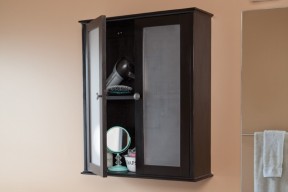
Storage space can be scarce, especially in the bathroom. Toiletries have a way of multiplying and overtaking all the available surfaces. To address this common conundrum, I designed this little cupboard from ready-to-use laminated pine shelving found at any home-improvement store. I chose a simple and versatile style, making this a perfect weekend project.
This cupboard is built with simple butt joints. Begin with the sides of the cupboard and cut them to length. Factory-laminated pine is often slightly thinner than standard 3/4"-thick sheets, and the measurements in the materials list assume 11/16"-thick stock. If you’re working with full 3/4"-thick wood, the final cabinet dimensions will come out slightly different than mine.
Cut the sides to size, then prepare 1/4" x 1/4" rabbets along their rear to accept the 1/4"-thick plywood back panel. Next, cut the shelf and the two mounting strips to width, and then trim all three parts to exactly the same lengths as each other. Sand these parts now, first using a 120-grit abrasive, then 180-grit. Join the sides to the ends of these parts using wood screws. If you decide to cover the screw heads with wooden plugs for best appearance, you’ll need to prepare counterbored holes to accept the specific plugs you’re using. See “Hiding Screw Heads” on page 58 for details.
After you cut the top and bottom pieces to size, you should add a bit of visual interest. I used a 1/2"-radius quarter-round router bit to mill the front and side edges of these pieces. Other decorative profiles work well too. After routing, attach the top and bottom pieces to the sides, creating a rectangular assembly. I used glue and #8 x 1 1/2"-long wood screws driven from the top and bottom, covered, once again, with tapered wooden plugs.

Cut the back panel so that it has a snug fit within the rabbets, but don’t attach it just yet. Screw the two mounting strips, which are the width of the cupboard opening, into place. These pieces will be used for fastening the cupboard to your wall. Next, it’s time to make the doors. The design I chose is simple enough for novice woodworkers. Start by cutting the rails and stiles to size, and then set your tablesaw to cut 1/2"-deep x 1/4"-wide panel grooves in the middle of the inside edges of all these parts. For the rails, you’ll also need to extend these grooves around the ends, creating a place for the door splines to interlock. The plans show how these splines are separate, free-floating pieces of wood that fit into the panel grooves in the stiles and the end grooves that you just cut in the rails. Prepare at least eight splines now, with grain running along their 1" length.
When you are happy with the fit of stiles, rails and splines brought together without glue, measure the dimensions needed for the acrylic door panels. I had mine cut to size at a glass shop. I sanded both surfaces of each panel evenly with 100-grit sandpaper on a random-orbit sander after peeling off the protective plastic. This process creates a frosted look that obscures your household medicines, toothbrushes and hair combs stylishly.
Check the fit of both door assemblies with the panels in place, but don’t add glue yet. The door stiles and rails need to be painted before assembly, including the panel grooves. Unfinished wood in the grooves may remain visible around the translucent panels otherwise.

Go over the project again with 180-grit sandpaper in hand, just to make sure all is smooth. I used a grey primer on the wood after final sanding, so that the semi-gloss black latex paint would cover more easily. Paint the inside of the cupboard and the back panel before attaching the panel with glue and pin nails. Door stiles and rails get painted now too, but mask the areas where the splines will go. These need to remain bare for the glue to grip. After all the paint is thoroughly dry and the doors assembled, protect the project with a clear semi-gloss urethane topcoat for a richer finish.
The doors are hung with European cup hinges, inset and flush to the cupboard sides. Decorative knobs finish off the project. When hanging your cupboard, be sure to find at least one stud for one of the screws driven through each of the mounting strips, with thread-in wall anchors for the other screws. I prefer metal drywall anchors, as they are self-tapping and have greater strength than plastic types. Once the cupboard is up, you can put your toiletries away and admire how easy it was to declutter your bathroom.
For tips on how to hide screw heads in your project, see this article.
| Part | Material | Size (T x W x L*) | Qty. |
|---|
| Sides | laminated pine | 11/16" x 7 1/2" x 27 3/4 | 2 |
| Top/bottom | laminated pine | 11/16" x 8" x 24" | 2 |
| Shelf | laminated pine | 11/16" x 6 1/4" x 21 5/8" | 1 |
| Back | laminated pine | 1/4" x 22 1/8" x 27 3/4" | 1 |
| Mounting strips | laminated pine | 11/16" x 2" x 21 5/8" | 2 |
| Door stiles | laminated pine | 11/16" x 1 3/4" x 27 3/4" | 4 |
| Door rails | 11/16" x 1 3/4" x 7 1/4" | 4 | |
| Door splines | laminated pine | 1/4" x 1 11/16" x 1" | 8 |
| Door panels | acrylic | 1/4" x 7 3/4" x 24 3/4" | 2 |
| Knobs | 2 | ||
| European cup hinges | 2 | ||
* Length indicates grain direction
No comments
To leave a comment, please log in
Don't have an user account? Register for free